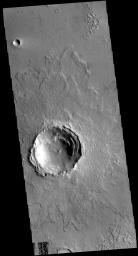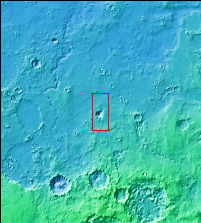
|
Rampart Crater
- Click the image above for a larger view
- Full-Res JPEG (1432 x 2655) (415.6 kB)
- Full-Res TIFF (1432 x 2655) (2.9 MB)
Caption:
This VIS image shows an unnamed crater in Acidalia Planitia. The margins of the ejecta are lobate and higher than the ejecta closer to the crater. This type of ejecta blanket is called rampart and it is thought that a volitile material like water may have played a role in creating this morphology. The crater is fairly pristine, and therefore relatively young.
Orbit Number: 62074 Latitude: 41.521 Longitude: 4.9399 Instrument: VIS Captured: 2015-12-11 22:48
Background Info:
Please see the THEMIS Data Citation Note for details on crediting THEMIS images.
NASA's Jet Propulsion Laboratory manages the 2001 Mars Odyssey mission for NASA's Science Mission Directorate, Washington, D.C. The Thermal Emission Imaging System (THEMIS) was developed by Arizona State University, Tempe, in collaboration with Raytheon Santa Barbara Remote Sensing. The THEMIS investigation is led by Dr. Philip Christensen at Arizona State University. Lockheed Martin Astronautics, Denver, is the prime contractor for the Odyssey project, and developed and built the orbiter. Mission operations are conducted jointly from Lockheed Martin and from JPL, a division of the California Institute of Technology in Pasadena.
Cataloging Keywords:
| Name | Value | Additional Values |
|---|---|---|
| Target | Mars | |
| System | ||
| Target Type | Planet | |
| Mission | 2001 Mars Odyssey | |
| Instrument Host | Mars Odyssey | |
| Host Type | Orbiter | |
| Instrument | Thermal Emission Imaging System (THEMIS) | |
| Detector | ||
| Extra Keywords | Crater, Grayscale, Thermal, Water | |
| Acquisition Date | ||
| Release Date | 2016-02-17 | |
| Date in Caption | 2015-12-11 | |
| Image Credit | NASA/JPL-Caltech/ASU | |
| Source | photojournal.jpl.nasa.gov/catalog/PIA20261 | |
| Identifier | PIA20261 | |

